
- Home
- Travel Packages
- Top Destination
-
Travel Attraction
By Category
Top Attraction

- Travel Agents
- Car Rentals
- Hotels
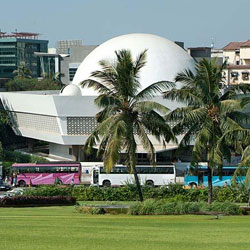
One of India finest architects J.M.Kadri designed this beautiful landmark building which houses Nehru Planetarium. Nehru Centre of Science is also located here. 8 Kms. from the city centre is located a centre telling about the universe. It unfolds the mysteries of the cosmos. They also screen regular film shows on the outer space, which are of particular interest for children. Close by is the Nehru Science centre, which is a science park, and permanent exhibits on intricacies of life. The antique models of Railway engines, aeroplanes, tramcar and steam lorry are exciting to see. Nehru Planetarium is the only astronomical centre in Mumbai, which is also a concert cum movie auditorium. This is the place, recreating the image of the sky as seen from anywhere on the earth at any time. It exhibits collections of lunar and astronomical photographs.
Explore More
Located in Worli the Nehru Science Museum with sound light gallery has an attractive childrens section. It is the only place, which recreates the image of sky as seen from anywhere on earth at any time. It also has a collection of warplanes, which served the Indian air force. Nehru planetarium was commissioned in 1977 and designed by one of India's finest architects I.M.Kadri. Nehru Centre, a trust headed by the Chief Minister of Maharashtra State, runs it. An astronomical exhibition, comprising of 40 exhibits (transparencies and working model) explain the cosmos. In the auditorium, a breathtaking 'Sky Show' captures the very essence of the Milky Way or Akashganga. Two hundred projectors are simultaneously trained onto a hemispherical ceiling made of aluminum. The effect is realistic and it is not surprising that the planetarium has attracted more than 3 million visitors.
Explore More
It opened in 1986 and now houses the Discovery of India exhibition, an art gallery, theatre and restaurant. Inspired by Nehru's book of the same name, it seeks to explore 5000 years of history by investigating the geographical, social, culture and political forces at play in the subcontinent. It's highly informative in a school trip kind of way. But then it's best to concentrate on just a couple of the major themes, such as the detailed exhibits depicting Nehru's life and times. Other interesting topics include the Mauryan Empire, the impact of the west and the struggle for independence. Children below five years of age not allowed into the Sky Theatre. The Nehru Planetarium is closed on Mondays. It was in 1972 that the Nehru Centre was conceived by the late Shri Rajni Patel and others as a living memorial to the maker of modern India, who symbolized the ideals of enlightened curiosity, scientific temper, secular values, a world view and above all, a faith in the people of India. The late Smt. Indira Gandhi laid the foundation stone of this magnificent dream on November 2, 1972 on a six-acre plot leased by the Government of Maharashtra.
Explore More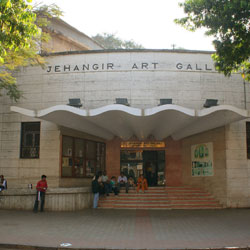
A prime art gallery in the city of Mumbai Jehangir Art Gallery caters to the artistic tastes of people. This is situated behind the museum and has four exhibition halls. Facing Elphistone College and adjacent to the Prince of Wales Museum, this gallery situated at Kala Ghoda is the most prestigious and modern venue for Indian artists. It was built in the year 1952. Managed by the Bombay Art Society, the entire cost of this beautiful mansion was donated by Cowasji Jehangir. This gallery is one of the city's most highly visible art galleries and having to exhibit a work of art here is a great treat for artists. The unending list of applicants to have their work put up on the walls of this gallery speak for itself of the great importance and the media attention one attracts. Some might have to wait a couple of years to have their work put up here.
Explore More
George Wittet designed this Indo- Saracenic style building, which houses the Prince of Wales Museum. It also houses a priceless collection of art, sculpture, a fine collection of miniature paintings and much more. Amid the hustle and bustle of Mumbai stand some stately buildings, remnants of the British Raj. Among them is the Prince of Wales Museum, named after Prince George (Later George V) who visited India in 1905 and laid the foundation stone of the building. Through the arch the Prince made his royal entrance to India as King George V for the Delhi Darbar in 1911. This four-tiered goliath houses a priceless collection of over 2000 miniature paintings from various stylistic schools in India. Among other artifacts feature a sizeable number of relics of the Indus Valley Civilisation and instances of Tibetan and Nepalese art.
Explore More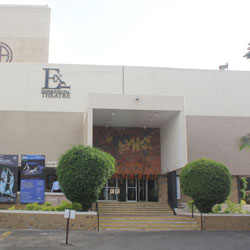
National Centre of Performing Arts
The National Center of Performing Arts was established in 1966 to preserve and promote India rich cultural heritage in classical and folk music, dance and drama. Apart from its traditional art schools, India also has a contemporary art lineage that began in the early fifties. While pioneers like MF Hussain and FN Souza spearheaded this modern art movement, Mumbai was the cradle of these brave new aesthetes. Today, contemporary Indian art is known to the world over, which can be viewed at the National Gallery of Modern Art bang opposite the Prince of Wales Museum. Converted from an old public hall, this dynamic, three tiered structure houses collections from India's best known living artists providing a convenient overview of the country's contemporary art scenario.
Explore More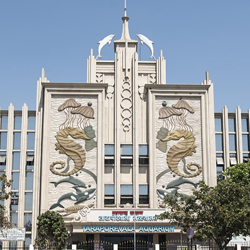
Mumbai is the financial city of the country. There are many places that you can visit while you are in the city. Among many other famous attractions, Taraporewala Aquarium, Mumbai is the oldest and the most famous. Located in the popular Marine Drive in the city, the aquarium has many marine and freshwater fishes. History of the Aquarium Taraporewala Aquarium, Mumbai was built in 1951 with the help of DB Taraporewala, a Parsee philanthropist, who donated a huge amount for the aquarium. It was inaugurated by India’s first president of India, Rajendra Prasad. It was renovated and reopened in 2015 and has glass aquariums all over. It houses more than 100 species of marine life such as fishes, stingrays, turtles, etc. Some of these marine lives are found only in Lakshadweep island. The place also has fossils that show the evolution of fishes. The aquarium is maintained by the Department of Fisheries. It has around 16 seawater and 9 freshwater, and 54 tropical tanks. The tropical section of the aquarium has different ecosystems like plantation, moss, island, etc. What will you See in the Aquarium? At the Taraporewala Aquarium, Mumbai you will find many freshwater and marine fishes that look beautiful. There is an acrylic glass tunnel that is around 12 feet long. There is a pool where you can touch the fishes and enjoy your visit. The beautiful fishes in the aquarium can leave you spellbound. What are Popular Attractions Here? When you enter the Taraporewala Aquarium, Mumbai, you will find oceanarium with a variety of fishes. There is also an amphitheatre with seating for around 50 people. The touch pool is the favourite place for children who are visiting this place. If you are tired of walking around the city and visiting this place, then enjoy a fish spa to rejuvenate yourself. The touch pool has more than 350 species of fishes. It is a wonderful place for children to learn and educate themselves. The aquarium is a perfect place to spend a day’s picnic. Different Species of Fishes in the Aquarium There are hundreds of species of fishes that you can enjoy in the Taraporewala Aquarium, Mumbai. You can witness Damselfishes such as moon tail, golden damselfish, striped, sergeant major damsel, cocoa, and electric blue. You see some tropical fishes, sucker, red tail, and Asiatic catafishes. If you think this is all that is there to see, then you can find different kinds of marine eels to amaze your eyes. Amaze yourself with a variety of butterflyfishes, triggerfishes, angelfishes, tangs, etc. You can also touch sea urchins, sea cucumber, tube worms, brittle star, starfish, etc. Other than these species, you can enjoy viewing batfish, golden travery, jelly fishes, dwarf lion, squirrel fish, negro, arowana, marine coral reef, whimple, etc. You will also enjoy witnessing alligators, octopuses, goldfish, sea turtles, seahorses, koi, red-earned sliders, etc. What is the Right Time to Visit the Aquarium? The best time to visit the aquarium is when the weather is nice. Even though it is indoor, the weather in the city can be harsh during summers. Except for Mondays, when the aquarium is closed, you can visit it from 10 am – 8 pm with a one-hour break from 1 pm – 2 pm. There is also a nominal fee for everyone. However, entry fees vary for children and adults. Also, you would need to pay additional charges for taking photos. How to Reach the Museum in Mumbai? You can reach the museum by train, bus, or taxi. The nearest train station is Charni road or Churchgate. You can then take a taxi or bus to reach the museum from either of the train stations.
Explore More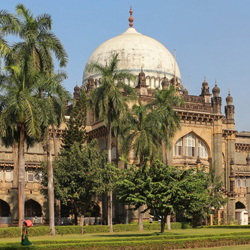
Traveling to Mumbai can be fun as the city has many beautiful beaches and attractions that can awe you. The nightlife of the city is very well known to people across the country. The people of the city are also known to be big foodies and hence, you will not be disappointed with the city when it comes to cuisines. However, the city also likes to keep its heritage and art preserved for people to see. Chhatrapati Shivaji Maharaj Vastu Sangrahalaya, Mumbai(CSMVS) is one such place that holdsart and cultural heritage. The museum was previously known as the Prince of Wales Museum of Western India. It has won awards for Heritage Building Maintenance by the Indian Heritage Society and the '2010 UNESCO Asia – Pacific Heritage Award' for Cultural Heritage Conservation. History of the CSMVS In the year 1905, a number of well-known people got together and decided on erecting a memorial for the Prince of Wales visit to the city. This led to the laying of the foundation stone by the Prince of Wales towards the end of 1905. The museum was then named Prince of Wales Museum of Western India. The building for the museum got completed in 1914. However, it was only opened to the public in 1922. From the years 1914 to 1922, the building was used as a military hospital and Children’s Welfare Exhibitions. Around the year 1998, the name of the museum was changed and now it is famously known as Chhatrapati Shivaji Maharaj Vastu Sangrahalaya, Mumbai. The building of the museum has been built in Indo-Saracenic style designed by the architect, George Wittet. It is built with buff-coloured trachyte Malad stone and Kurla basalt stone. The interiors of the museum reflect an 18th century Maratha mansion. It houses around 50,000 artefacts consisting of miniature paintings, excavated artefacts, European paintings, ancient statues, etc. What to Expect Inside the Museum? The Chhatrapati Shivaji Maharaj Vastu Sangrahalaya, Mumbai is known to have a huge collection of ancient Indian artefacts. You can also find some of the best miniature paintings from across the country. You can get awed by the amazing collection of decorative art objects in textiles, jade, ivory, wood, metal, etc. The museum also houses artefacts from Nepal and Tibet which show religious and artistic importance or heritage. The museum also houses a Numismatic collection that displays important issues and matters over a period of time. If you thought this is all, then you will be amazed to see a huge collection of Japanese and Chinese porcelain, embroidery, metal, and ivory objects. As part of the art collection, the museum also houses European oil paintings and Indian armours and arms. There are many artefacts that have been excavated in the country and outside the country too. Some of these artefacts have been excavated by the renowned archaeologist, Henry Cousens. Many well-known personalities contributed to the collection of the artefacts that are displayed today. Enjoy the CSMVS Children's Museum Chhatrapati Shivaji Maharaj Vastu Sangrahalaya, Mumbai has something for everyone, and this includes the children too. The museum has a museum and creative space for children where they can learn and get creative. The open space in this part of the museum helps the children to get creative, learn through various kinds of exhibitions, workshops, activities, etc. The museum displays exhibit the work of various young curators to encourage them to grow. The museum also has competitions for budding artists. The children can enjoy the tour of various interesting exhibits. They can also enjoy the interactive activities offered by the museum such as drawing and painting of animals and masks, puzzles, games, etc. Kids can also start their own panchayat class where they will be given problems that they have to solve. For a child who loves reading, the museum also offers them a wide collection of books and a peaceful corner for them to read. When to Visit the Museum Chhatrapati Shivaji Maharaj Vastu Sangrahalaya, Mumbai is a great place to visit with family, children, and also for tourists. The museum is open the whole week from 10.15 am – 6.00 pm. The museum has a nominal entry fee for children and adults. Students and senior citizens can get discounts on showing their id cards. If you want to take pictures inside the museum, then you will need to pay a little extra. Even though you are allowed to carry tripods inside the museum, selfie sticks are not allowed. How to Reach the Museum? The nearest terminuses to the museum are Churchgate and Chhatrapati Shivaji Terminus. They are around 20 minutes walk from the museum. If you do not feel like walking to the museum, then you can take an auto-rickshaw or a taxi. There are also some public buses that ply on the route. Tips for Visitors to CSMVS If you are planning to visit the museum, then be prepared to spend a few hours exploring it. The museum offers floor plans at all the floors that can help you in guiding your way to the exhibitions. It is a visitor-friendly museum that has lifts for people who are not able to climb stairs. You can also ask for wheelchairs from the museum’s Information Desk. The museum has a collection in Braille to help the visually impaired to enjoy the exhibits. There are special tours that are organised by the museum for visually impaired. If you are carrying too many bags with you, then you can leave it at the baggage counter in the museum. It also has an audio guide at a nominal price. You can choose guided tours by choosing to contact the authorities in the museum in advance. However, these tours need to have at least 25 people in a group. If you are hungry during your tour of the museum, then they have a café where you can enjoy some snacks and beverages.
Explore More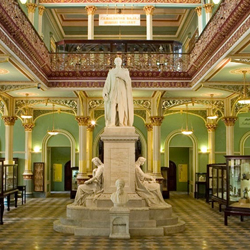
As the oldest museum in the city Dr. Bhau Daji lad museum, Mumbai was established in the year 1855. The museum reflects the city rich history and cultural heritage with its rare collection of decorative Art which showcases the craftsmanship of different communities of the city presidency. The museum also demonstrates the city history beginning from the twentieth century with its collection of rare books documenting the life of people living in the city at the time, photographs, maps, clay models, etc. Traveler tips The museum is open every day except for Wednesday from 10:00 am to 6:00 pm. Apart from this, the museum is also closed on public holidays. The entry fee for Indian residents visiting the museum is rupees 10 for adults and rupees 5 for small children while for foreigners the entry fee is rupee 100. To thoroughly explore the museum tourists require at least 2 to 3 hours in hand exploring the place to the fullest. While the museum is wheelchair user friendly however photography is not allowed on the campus. Registering on the official site will help the tourist to understand the details of the museum along with upcoming events and also allow easy access to the museum. Things to do There are tons of activities which both the adults and kids can enjoy simultaneously, children activities include workshops, and treasure hunts, etc as for adults various educational lectures on history, arts, educational programs on music, films, etc are available. One can even explore nearby cafes, restaurants, bookstores, etc too for fun-filled trips to the museum. Availability Dr. Bhau Daji lad museum, Mumbai offers tour guides both for public and private tours. The tour guides are experts in several languages like Hindi, English, and Marathi, etc thereby catering to different age groups. The museum also offers audio guides for tourists. History The museum was first opened for public viewing in the year 1872.Dr. George Birdwood led the team of the fundraiser and conceptualized the design element of the museum with Dr. Bhau Daji after whom the museum is renamed in the year 1975. The museum committee had members from all different religions and was built in the honor of Queen Victoria. The museum was closed for full five years due to its revamping by INTACH. Architecture Since Dr. Bhau Daji lad museum, Mumbai is the oldest museum and its architecture is that of the British era. The museum also received a UNESCO Asia Pacific Heritage award of excellence for heritage conservation. It is the city's oldest museum but it also reminds of the architecture of the 19th century. The main hall of the museum is the double-height volume where galleries are placed. The Statue of Albert is placed in the central hall which showcases a collection of Indian arts and crafts along with other art and crafts famous in Europe then. Festival There are lots of festivals celebrated in Mumbai but Ganesh Puja is famous and it is celebrated with great enthusiasm. Diwali and Janmashtami also celebrated with great joy. Best time to visit Since Dr. Bhau Daji lad museum, Mumbai is open all through the year and fully air-conditioned tourists can visit the museum anytime. However for a unique traveling experience, one can visit the museum during certain events hosted by the museum for a memorable trip. How to reach The museum is well connected with rail and road with both Mahalaskmi and Byculla railway station being nearby. There are also tons of buses available that frequent to the museum at regular intervals. Interesting facts and trivia about The museum has won a UNESCO Award in the year 2005 for excellence in heritage conversation. Another interesting facet of the museum includes that the quixotic design in the museum roof is named after Jewish patron David Sassoon and is known as’ star of David ‘. The museum was earlier known as Victoria and Albert Museum. FAQ Before visiting the museum one must keep in mind the timings of the museum and also make sure those belongings of the museum should not be damaged. Thus visit this beautiful place Dr. Bhau Daji lad museum, Mumbai, when you are, happens to be at Mumbai.
Explore More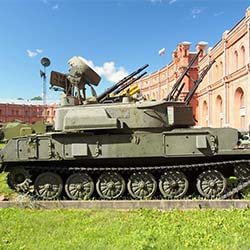
The Artillery Museum in Nashik is the biggest artillery museum in not just Maharashtra or India but Asia as well. It was relocated to India during the India-Pakistan partition. It is spread across 2 floors and is considered one of the best artillery centers in India for training the pupils of the Indian Army. On display in this museum are a number of vintage and modern weapons that offer a sight to behold to all the visitors. It is located behind the hills of the beautiful Pandavleni caves and on the foothills of the Sahyadri Mountain Range. This beautiful location makes it an even more appealing tourist spot. Bofors guns, cannons, tanks, military agreements, and different paintings and pictures of historical events are also showcased in this museum. It Is Known For:-1) The humongous size and the countless modern as well as vintage weapons that it has on display.2) The beautiful location that is right on the foothills of the Sahyadri Mountain Range and behind the Pandavleni caves.3) The photographs and paintings of the memorable historical events that took place in the history of India-Pakistan partition.4) The AOP and the MIG-23UM aircrafts that are on display also attract many tourists.Best Time To Visit:-The months from October to March are great with respect to the weather of the city as these are cool months when you can easily stroll through the city and enjoy your time. The national holidays and other special days like Army day etc., are also a great time to plan a visit to this artillery museum to see special preparations.Reaching There:-Reaching the Artillery Museum in Nashik is very easy owing to its location in Deolali Gaon in Nashik. It is easily connected by the road and local transport and buses can take you here.Nearest Airport:- Ozar AirportNearest Railway Station:- Nashik Road Railway Station
Explore More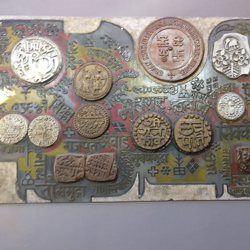
Coin Museum is one of the renowned museums in Nashik, Maharashtra in India. The museum has a fine collection of coins that portray the research and well-documented history of Indian currencies. This museum is the only museum of its kind in Asia constructed in 1980 underneath the Indian Institute of Research in Numismatic Studies. The environment of the museum is very cool and calm, as it is situated in the backdrop of the fascinating Ajneri Hill of Nashik History The coin museum was constructed to convey a universal idea about Indian coins to the common people. Coin museum provides an immense idea of the Indian coinage from the most primitive period to the present times with the support of coins, moulds, dyes, imitations, photos, and transitory write-ups. Not just the casting and machine are outstanding, but the museum also displays dioramas of depicting coin casting and coin manufacturing systems. You will also come across with numismatic material like bronze, terracotta\'s, copper-hoard stuff, canvases and some other historical articles as displayed there beautifully. This campus extends over an area of 505 acres of land. However, the wonderful weather here is due to the surrounding Anjaneri hills. When to Visit? As the museum is set at a wonderful place surrounded by Anjaneri hills, you can visit the place in every season. Temperature remains moderate throughout the year. Tourist attractions in Nashik If you are planning for a visit to Nashik then you must be aware of attractive tourist spots here, apart from coin museum. Panchvati It is a peaceful town set near Nasik. This place offers small sightseeing which would let you have a glimpse of the ancient world where the exile of Lord Ram, Sita and Laxman took place. There are banyan trees all around and the place is filled with an air of spirituality. Sula Vineyards This vineyard is an Indian winery situated in Nashik in India and the valley's first commercial winery. It also has been awarded a silver medal for its 2012 Sauvignon Blanc is the leading winemaker in India. The vineyard houses a resort to live in the middle of the winery along with a tasting room. This is the place where people can taste different wine samples with some exclusive varieties produced at the winery. Dudhsagar falls As far as the view is concerned, this is considered as one of the best falls. Dhudsagar falls deliver a panoramic view with remarkable scenery. This cascade is in full vitality during the rainy season and moderately a wonderful sight to observe. Saptashrungi Located on a hill range that includes seven hills, Saptashrungi is a place of religious consequence for Hindus. The determination to the temple is reasonably picturesque, especially throughout the heavy rain season. Trimbakeshwar Located at the source of river Godavari Trimbakeshwar is about 38 km away from Nashik. Suspended on the highest peak of Brahmagiri hills, Trimbakeshwar treasures one of the 12 Jyotirlingas of Deity Shiva in India. At first, there were supposedly 64 jyotirlingas among them 12 remains and are considered to be divine. Every site with one of the twelve jyotirlingas takes the name of the leading deity. Every single piece of the sacred shrine is considered to be a different manifestation of Shiva. Nashik caves Pandu Leni is also recognized as Nashik Caves. These are a group of 24 caves carved between the 3rd century BC and the 2nd century AD. These caves are representing the Hinayana Buddhist principles. Out of these 24 caves, two caves prominently the centre of attraction. The numerous engravings on the caves express that all the three kings that ruled Nashik at that time, specifically, the Satavahanas, the Kshatrapas, and the Abhirs fully reinforced Buddhism; however, they were not Buddhists in the real logic. Anjaneri Hills Anjaneri is known as the birthplace of Lord Hanuman and this place derived its name from Hanuman's mother Anjani. Hovering in the picturesque mountain range of Nashik-Trimbakeshwar, Anjaneri fort is situated at a distance of 20 km from Nashik. Kapileshwar temple One of the primogenital illustrations of this pilgrim city is that the place is a Shiva temple surrounded by an indication of secret due to the absence of a sculpture of Nandi Bull, usually originated in all Shiva Temples. this is one of the most frequented temples close to the Kalaram temple, in Nashik. Jain temple A fresh addition to the sacred places in Nasik is a straggling and elegant structure, the Jain Temple. The structure consists of three storeys and is constructed mainly in white limestone and pink sand. One can view the magnificent statues of 12-ton heavy deity of the 24th of Tirthankara of the Jains. Gangapur dam Gangapur Dam is an excavated dam on River Godavari. It is also famous as the longest clay reservoir in Asia. People come here to pass a peaceable afternoon on the garden by the river, adoring the wonderful, attractive backdrop of the river, straight out of a dream. One can also spot migratory birds in the evening, and there is a new boating capacity to entice more travellers. Kumbh Mela Nashik The mass Hindu sacred trip of Kumbh Mela includes gathering in a massive number here. The purpose of Hinduism followers is to bathe in a sacred river. Dhodap trek Dhodap is a wonderful trek to the fort in Maharashtra. Being one of the many forts at a height in the district of Nasik, it is situated at an altitude of about 4700 feet from the ground. Hence, it gives an exhilarating experience to fun lovers. Various treks are there to explore for trekking enthusiasts. How to Reach? Distance from Nashik CBS Bus Station is 19 Kms which can easily be covered by bus or cab. Visiting Hours: 9.30 morning- 1.00 afternoon and 2.00 afternoon - 5.30 evening It is closed on Sundays and all official holidays. Make a plan to visit this place by booking tour package to Nashik online.
Explore More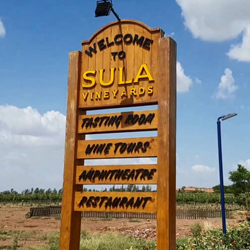
The Sula Vineyards is a famous winery of India. It is located in Nashik, 180 km to the northeast of Mumbai. This is the leading winery of India renowned for its assortments of grape wines, such as Chenin Blanc, Riesling, Zinfandel and Sauvignon Blanc. Considering the environment, this place is an ideal getaway for people who are tired of routine life and wish to spend their weekend or day off in relaxation, away from the commotion of the city. The atmosphere and surroundings of this winery are so wonderful that the visitors do not even realize they are actually in India. The picturesque views makeover them into a different world altogether. History of Sula Vineyard The Sula Vineyards was originated by Mr Rajeev Samant in 1998 who quit his commercial job in foreign just to come back to India. After his return, he established Sula vineyard. What trailed were researches with a variety of yields like teakwood, mangoes, roses and table grapes. Keeping in mind the country's seasonal conditions and temperature, finally, it was determined that wine grapes were the superlative crop to grow in India. Further, he took final consultation from Kerry Damskey, a Californian winemaker. And finally, Samant set up his first winery in Nashik- Sula Vineyard. Sula came from Samants' mother's name-Sulabha. With time newer varieties of grapes introduced, and the company extended its product assortment and collection. Now, Nashik is known as the Wine Capital of India that houses around sixty different wineries. Architecture From its establishment, the company started from a just 30-acre estate in Nashik. However, it has now stretched to around 1800 acres range across Nashik and Karnataka. This large estate is available to visit by the common public for a tour of wine tasting and roaming into the vineyard on all days throughout the year. This is why it has become a famous tourist spot and has gained immense popularity over the years. Availability Sula Vineyards house approximately sixty wineries and brags the title of being the first-ever winery in the entire nation. The Grape Trudging fun activity that takes place between January and March is a furthermore delight to the visitors here. The vineyard also consists of two restaurants that serve mouthwatering food, a gift shop and a bottle shop. The vineyards also house a resort to live in, a winery, and a tasting room where people can sit and taste different samples and varieties of wines produced at the winery. How to Reach Sula Vineyard? Nashik is reachable by all means of transport from nearby states. It is around 180 km from Mumbai and 210 km from Pune. Festivals celebrated 1. Grapes stomping The reaping and crushing season usually falls between January and March, hence, the perfect time for arranging and conducting grape stomping as a fest. Grape stomping is a Roman tradition including the crushing of grapes with one's bare feet. One can simply enjoy as it is an experience that you absolutely should not miss. 2. Sula fest A live music festival is also arranged at the vineyards, which is known as SulaFest. It takes place every year at the winery. This is a two-day epicurean world music festival which started in 2008. It offers its guests some incredible food and drinks with memorable music. Tourists who pay a visit during this festival can engage themselves in grape stomping, wine tasting and camping at the same festival. Tips For Visiting Sula Vineyard 1. The Sula vineyards is a major wine tourism destination. This is the reason for a huge influx of visitors and wine lovers during weekends and vacations. It is consequently recommended to visit this amazing place of attraction on weekdays for a peaceable and tranquil experience at the vineyards. 2. A tourist has to pay INR 37 for the Taste and Buy Package. This includes the expedition only which is an exclusive tasting of six wines with the Sula Winemakers. 3. If you are a wine lover then sign up for VIP tasting or customized premium tasting in small groups. This is the way to make the most out of your holiday. Nearby places to visit in Nashik When to Visit? You can visit the place every season due to its beautiful, serene and cool environment. The temperature remains moderate throughout the year. Tourist attractions in Nashik If you are planning for a visit to Sula Vineyards in Nashik then you must be aware of attractive tourist spots here. Panchvati It is a peaceful town set near Nasik. This place offers sightseeing which would let you have a glimpse of the ancient world where the exile of Lord Ram, Sita and Laxman took place. Dudhsagar falls As far as the view is concerned, this is considered as one of the best falls. Dhudsagar falls deliver a panoramic view with remarkable scenery. This cascade is during the rainy season and moderately a wonderful sight to observe. Saptashrungi Located on a hill range that includes seven hills, Saptashrungi is a place of religious consequence for Hindus. Trimbakeshwar Located at the source of river Godavari Trimbakeshwar is about 38 km away from Nashik. Suspended on the highest peak of Brahmagiri hills, Trimbakeshwar treasures one of the 12 Jyotirlingas of Deity Shiva in India. Nashik caves These are a group of 24 caves carved between the 3rd century BC and the 2nd century AD. These caves are representing the Hinayana Buddhist principles. Out of these 24 caves, two caves prominently the centre of attraction. The numerous engravings on the caves express that all the three kings that ruled Nashik at that time, were not Buddhists in the real logic. Anjaneri Hills Anjaneri is known as the birthplace of Lord Hanuman and this place derived its name from Hanuman's mother Anjani. Hovering in the picturesque mountain range of Nashik-Trimbakeshwar, Anjaneri fort is situated at a distance of 20 km from Nashik. Book Nashik tour package to include every enthralling tourist spot of Nashik in your vacation. Online travel agents can help you get the best deals.
Explore MoreMumbai - Aurangabad - Ajanta - Ellora 6 Nights 7 Days Tour
7 Days/ 6 Night
Aurangabad - Mumbai
Shirdi Darshan
2 Days/ 1 Night
Shirdi
Tadoba With Nagzira - Pench National Park Tour 6 Night
7 Days/ 6 Night
Chandrapur - Nagpur - Seoni
2N - 3D Mahabaleshwar Tour Ex - Mumbai
3 Days/ 2 Night
Mahabaleshwar - Panchgani

Aga Khan Palace, Pune was built in the year 19892 by Sultan Mohammad Shah Aga Khan III to help the people of Maharashtra who were affected by famine. The palace was considered to be a charitable place that was led by the spiritual leader of the Nizari Ismaili Muslims whose aim was to help the people suffering from famine. In 2003, the palace was declared as a monument of national importance by the Archaeological Survey of India. The palace is also linked to India's freedom movement as it was where Mahatma Gandhi was imprisoned with his wife Kasturba Gandhi, Sarojini Naidu, and his secretary Mahadev Desai. This was also the place where Mahatma Gandhi’s wife and secretary died. It is an ideal place for photography as it is surrounded by a beautiful garden. History of Aga Khan Palace, Pune The palace has a historical significance linked to the Indian Freedom Movement and the Quit India Movement. Between 1942 and 1944, Mahatma Gandhi along with his wife, secretary, and Sarojini Naidu were held as prisoners. However, Kasturba Gandhi and Mahadev Desai died during the imprisonment and their samadhis are located in the palace. It is said that Sultan Mohammad Shah Aga Khan III wanted to help the famine struck people in the surrounding areas, so he decided to build the palace by employing the people. He employed more than 1000 people and built the palace within 5 years. The palace covers around 7 acres of the total 13 acres of land. The rest of the land is covered with a well-maintained garden. In the year 1969, Aga Khan IV donated the palace to Indians as a mark of respect for Gandhiji and his philosophy. The palace was also the place of National Model School until the year 1970. Today the palace has become a memorial of Gandhi and has his ashes. Structure and Significance of the Palace Aga Khan Palace, Pune is a two-storeyed that comprises of five halls, spacious lawns, huge rooms, etc. A red wall in the palace has a Marathi poem that has been dedicated to Kasturba Gandhi. The palace is a peaceful place to walk around. It is surrounded by tall trees. With its grey structure and red slanting roofs, the palace creates an ambience of peace and richness. The memorial stones of Kasturba Gandhi and Mahadev Desai have a tulsi plant on the top. The stones are placed where they were cremated. The ashes of Gandhi are also placed in the palace and a memorial with a tulsi plant on the top can now be seen in the place. You can also learn the milestones engraved in the palace of Gandhi in the palace and also detailed information of the palace. Aga Khan Palace, Pune – A Gandhi Museum The rooms that were used by the Gandhis are now part of the Gandhi museum. The rooms show simplicity through their style and limited accessories or needs such as utensils, slippers, letters, and clothes. The entrance hall of the palace has a large statue of Gandhi and Kasturba Gandhi. You can also find large paintings and black and white pictures of Gandhi. One of the epic pictures can be seen in the museum that shows Gandhi with a begging bowl collecting donations for Harijans. You can also find a letter written by Gandhi after the death of his secretary, Mahadev Desai. You can enjoy taking pictures of the historical museum. Apart from these, you can also see a library, buy books from the bookstall that has works of literature of Gandhi, sales outlet of Khadi Gramodyog, a training centre for women, and children’s film club. Events Celebrated in the Aga Khan Palace, Pune Many events are celebrated in the palace. These include Republic Day, National Girl Child Day, Mahashivratri, Gandhi’s Death Anniversary, Gandhi Jayanti, Independence Day, Women’s Day, and Children’s Day. These events are organised by the Gandhi Memorial Society. Visiting Hours of the Aga Khan Palace, Pune The palace is open throughout the year except on national holidays. You can visit the palace between 9 am – 6 pm. The palace has a very nominal fee charged for adults and children. However, you may not be able to take photographs in the palace as it is restricted. Best Time to Visit the Palace The best time to visit the palace is between October to March during which the weather is favourable. Summers can be harsh in Pune and hence it is not the best time to do sightseeing at the time. How to Reach the Palace The city is connected by air and train. However, there are also state-run buses and private buses to Pune. However, if you are already in the city, then you can take a rickshaw or a taxi to visit the museum. Places to Visit Near the Palace Other than the palace, there are many other places that you can visit near it. You can visit the Shaniwar Wada, a historical landmark of India that was once a residence of the Peshawas. If you are visiting the palace, then do not miss to visit the Rajiv Gandhi Zoological Park that houses a variety of animals and reptiles. Another famous place that you can visit near the palace is the Empress Garden which is a well-preserved garden. If you are looking solitude, then Osho ashram is the best place to be near the palace. Lal Mahal is yet another place that reflects the history of the Maratha empire’s bravery and heroic acts. If you want more of Indian history, then you can visit the National War Memorial which is very close to the palace. Get a feeling of spirituality and peace by visiting the Pataleshwar Temple which has many mythical stories and mysteries surrounding it. The temple is dedicated to one of the reincarnations of Lord Shiv, Lord Pataleshwar. You can also dive into the cool water in Diamond Water Park. There are many other such places near the palace that you can visit.
Explore More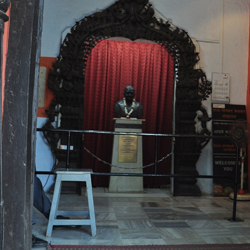
The huge collection of different items from different categories is what makes Raja Dinkar Kelkar Museum a place where you should all visit at least once. From painting to sculptures and even different types of musical instruments can be found here to kill the hunger of history and art inside you. Pune is the city that has seen rapid development and also the changing face of the country. It is the centre of the IT, business, research, automobile, and even education sector. This cosmopolitan city is also has a tinge of ancient times. The city has people who have high quality and standards of living which is depicted by the international restaurants, swanky malls, and other commodities that we see in urban life. Along with all these, it is also a torchbearer of the Marathi culture. Ganesh festival is the best and well-celebrated festival and one must come and experience in here. The beautiful tourist places in Pune are the symbol of great history and it tells its own story. With the time it saw several battles and have endured the rest of the time. Same as other attractions, the Raja Dinkar Kelkar Museum, Pune will take you to a mesmerising journey down the timeline of the history of India. You will be fascinated by the beautiful collection that they have for you. But before you go there are certain things that you need to know about the place. Traveller Tips There are some tips to remember if you are visiting Raja Dinkar Kelkar Museum, Pune. • There are various sections that you will get in the museum that you must visit thoroughly and separately to get a better idea of history and art. • The various departments that are here are as follows: 1. Indian paintings 2. Vanita Kaksha 3. Gujarat gallery 4. Lamps 5. Musical instruments 6. Ivory objects 7. Mastani Mahal 8. Sculpture 9. Tambol Things To Do Visiting Raja Dinkar Kelkar Museum, Pune you can learn about different facts about the Maratha culture and the vast history behind it. All your misconceptions will be cleared once you visit here. People And Language The most widely spoken and the official language of Pune is Marathi. Hindi and English are understood and spoken by people here. There are other people as well who have settled in Pune for earning and educational purposes and they speak their native languages. Pune is home to people who belong to different religions, caste, region and cultures. Despite if the differences in the people here, there is still harmony and peace with each other. The reason behind the diversity is the multinational companies and different industries. Various institutions, colleges, universities have also attracted people from all parts of the county. This city is the ideal place for all the IT sector. Popular Culture Pune is a cosmopolitan city which is considered the cultural capital of the state Maharashtra. This is the city where you can see modern and traditional culture combing. The Ganesh festival is the apt representation of culture. The city is decorated with diyas, lights, flowers and much more for 10 days. Other festivals that are celebrated here with joy and happiness are Christmas, Eid, and New Year. This place is also the city of music, art, theatre, and dance. There is also a world-famous classical music festival celebrated here. There are several platforms and theatres for new actors and actresses. Pune is also a city for foodies. No matter whether you are south Indian, Punjabi or belong from any other part of the country, you will get all kinds of food in Pune. Best Time To Visit Earlier, this city was blessed with mild and pleasant weather throughout the year. But as time went by and the green cover removed due to industrialisation and urbanisation, the summers become hot and humid and even difficult to survive. The winter season is the best time to visit Pune which lasts from Nov to Feb. The weather is pleasant in these months and you can explore the city better. As Raja Dinkar Kelkar Museum, Pune has nothing to do with the weather outside, it can be visited at any time of the year. Thus, you can come and visit the museum at any point of the year when you find it convenient and comfortable. Apart from all Pune is a lovely city that can be visited at any time of year but the specific time is the winter season when you will find the weather at its best. How to Reach? The railways are the best mode for transport as it connects different places. Therefore Pune is easily accessible. After you have reached the station, you can get any cab and visit Raja Dinkar Kelkar Museum, Pune. Cabs are also the easiest method of transportation here. The airports of Pune or Pune airport is just 10 km away from the main city. You can land and take a cab and taxi to the museum. Interesting Facts and Trivia There are some interesting facts about Raja Dinkar Kelkar Museum, Pune about which you must know. Some are: • Dr. Dinkar Kelkar starting a collection in the year 1920 and by 1960. He collected over 15,000 artifacts that are there on display. • Many schools take their students here to enjoy and learn more about history and culture. • The museum shows us the beautiful and amazing history of the Marathas and their amazing culture. Therefore you can clear all you doubt that you get all over the internet by visiting this place. Thus, visit this museum and enjoy your holidays and learn about history and culture. You will feel knowledgeable and also will find yourself in the past.
Explore More
Prachin Konkan is a well-known tourist attraction in Ganapatipule, Maharashtra. It is an open-air museum that is spread over 3 acres of land. Being an open-air museum, it reflects the ancient Konkan lifestyle. This museum was built in the year 2004 and it gained an immense popularity within a shorter period of time. Visitors from different parts of Maharashtra visit this museum to know the culture and lifestyle of the Konkanis in the previous era.It Is Known For:-1) As per the name ‘Prachin Konkan’, it translates into ‘Ancient Konkan’. This museum is a place that tells about the lifestyle of the people of Konkan region 500 years ago.2) The entire museum is set amid the green surroundings of a small forest. There are various exhibits that narrate about the Konkani people, their culture, profession, and much more.3) There are various sculptures like the potter, snake charmer, tribesman, barber, cobbler etc.4) A sculpture of Chhatrapati Shivaji and Lord Parshuram has also been installed in this museum because Konkani people had a lot of faith in them.5) A particular section of this museum is dedicated to the vast collection of pearls and seashells. The rarest seashells are displayed the gallery.Best Time To Visit:-Prachin Konkan is one among the must-see tourist attractions in the region of Ganapatipule. Since it draws visitors on a large scale, this place can be visited throughout the year. The summer and monsoon are the seasons that should be avoided while visiting this museum.The entry to this museum is free for kids but paid for adults. Photography is chargeable and is strictly not allowed in the pearl gallery.Reaching There:-Prachin Konkan is a famous tourist attraction and has a well-established connection of roadways and railways. The local jeeps, vans, and taxis are the best mode for visiting this place.Nearest Railway Station:- Ratnagiri Railway StationNearest Airport:- Ratnagiri Airport
Explore More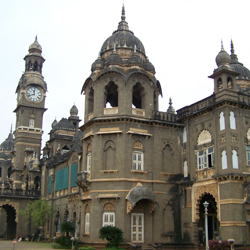
Kolhapur is a very famous city known for its spices and footwear in Maharashtra. If you are planning a vacation in the city, then you should not miss out on the famous cuisines, shopping items, and touristic places. Among many other tourist places, Shahuji Chhatrapati Museum, Kolhapur is a place you must put on your list. The Famous New Palace Kolhapur’s famous New Palace is very famous in the city as it is carved out of black polished stone and was built between the years 1877 and 1884. The palace was the home of Chhatrapati Shivaji and his heir Chhatrapati Shahuji. Today, the palace has the Shahuji Chhatrapati Museum on the ground floor which is, yet another, tourist attraction. The palace was created in the Indo-Saracenic style by British architect Charles Mant in 1881. What to See in Shahuji Chhatrapati Museum? The museum is one of the places that you must visit when you are in Kolhapur. The museum has weapons, costumes, jewelleries, and other such collections from the Maharaja’s time. It also has a huge collection of items owned by Maharaja Shahaji Bhonsle Chhatrapati such as trophies, guns, etc. The museum depicts the culture, tradition, and art during the reign of the Maharajas. These include Lathi, wrestling, Danpatta, rare paintings, arterials, etc. It also has stuffed animals and birds that are part of the attraction for the children in the museum. The Darbar Hall is located right in the middle of the palace. On one side, you can see the life of Shivaji Maharaj being depicted through a glass painting. On other sides, you can witness the carved columns that depict temple-like brackets. You can also see the throne at the end of the darbar. What is Inside the Palace? Apart from the Shahuji Chhatrapati Museum, the palace has a beautiful green garden. It also has a small zoo with deer, ducks, and peacocks along with a spectacular lake. You can also enjoy the photos of one of the Maharaja’s love for hunting and how to train a cheetah. When to Visit the Museum? Shahuji Chhatrapati Museum can be visited on all days except for Monday. However, there are timings applicable during the visiting days. You can visit the museum from 9 am – 1 pm and 2 pm – 6 pm on all days. Are there Any Entry Fees? Even visiting the New Palace is free, the museum has a nominal entry fee for its visitors. The entry fees vary and can be checked out on their website or at the museum itself. How Long does it Take to Cover the Museum? If you are planning to visit the museum only, then it does not take more than 1 hour to cover the whole museum. However, if you want to include your visit to the whole New Palace, then you need at least 2-3 hours to enjoy the beauty of the palace. What is the Best to Visit the Museum? There is no best time to visit the Shahuji Chhatrapati Museum as it is open throughout the year. However, visiting the city during peak summer is not a very good idea. Hence, try to visit the city when the weather is good, i.e. between November and February. Ways to Reach Shahuji Chhatrapati Museum Kolhapur is a city that is visited by many people every year. Hence, it is quite accessible and finding transportation within the city is not difficult. Some interstate buses and trains can be boarded to reach the city from Mumbai, Pune, Solapur, Panaji, etc. These cities have buses run by the Kolhapur Municipal Transport service. You can also hire a taxi to reach the city. To reach the museum you can hire a taxi or rickshaw within the city.
Explore More
The city of Kolhapur in Maharashtra is better known as Dakshin Kashi among the tourists. It is known as one of the most joyous and prosperous city of Maharastra and the entire country. The city is dedicated and influenced by goddess Mahalaxmi. It carries a wide range of cultural and archaeological tradition. It also has several lakes, incredible temples, magnificent forts and gardens. Among its several architectural monuments, Mahalaxmi temple, Khasbhag Maidan and New Palace – Shahu Museum are important attractions. But your Kolhapur tour will remain incomplete without visiting the Town Hall Meuseum. Description: The Town Hall museum is spread over a huge location of Kolhapur in Maharashtra. The museum space includes a number of government structures such as telephone offices, courts, offices, etc. And, the museum is counted as the top-most attraction of the city. Inside the museum, you can spot some ancient tokens of Brahmapuri civilization such as coins, beads and fragments of pottery. Some eccentric pieces of sculptures are also displayed there which have been rescued back in the history from the Malaxmi Temple. You will get to spot a number of eminent collection of sculptures exhibited there but among them that of a female attendant who is bearing a fly-whisk of Panhala, is a memorable one. The bronze bell is another major attraction of Town Hall, Kolhapur, which was brought from Vasai during 1979. There is a gallery at one end of the museum which is displayed with arms. The museum campus also has Chhatrapati Pamela Raje hospital. The entrance of the hospital displays Corinthian columns and monkeys guard those. The museum premise is decorated with beautiful fountains, good looking trees and Mahadevi Mandir, which all together gives a complete look to the entire location. Things to Do: The entire area of Town Hall, Kolhapur is huge and it has a number of government buildings in its premises. You can visit the Town Hall garden and museum, both attracts tourists’ attentions. You can roam around as the area is very well decorated with beautiful flowering trees and lovely fountains. You will also love to spend some time visiting Mahadevi Mandir there. Town Hall remains closed on Sundays. Otherwise you can can visit any other day of the week between 9 AM and 5 PM. History: The architecture of Town Hall is one of the most popular attractions of Kolhapur. Charles Mant has founded this building during 1872 – 1876. The significance of this construction is it is the only one to reflect Neo-gothic architecture. The museum of Town Hall has elements from the ages of Satavahana period and among them the statues of Greek God, Hellenistic figures’ medley, Poseidon and elephant riders holds significant importance in history. Best Time to Visit: It is advised for the tourists that they should visit Town Hall during June to February as through this time weather remains almost pleasant here. How to Reach: You can easily reach Kolhapur by rail, air or roadways. By rail – the nearest railway station is Chhatrapati Shahu Maharaj Terminus. To reach Town Hall, you can hire private cabs or ride on local buses. By air – Ujalaiwadi airport is the nearest airport to Kolhapur. It is only 10 km away from the city. To reach Town Hall, you can hire private cabs or ride on local buses. By bus – state bus services are available between Kolhapur and Mumbai. It is an 8 hours’ journey. Kolhapur is more close to Pune. It is a 3 hours’ drive. You can ride on buses or come by car. FAQ: Popular tourist attractions in Kolhapur • Bahubali Atishayakshetra & Jahaj Temple • Rankala Lake • Panhala Fort • Mahalaxmi Temple • Jyotiba Temple • Chandra Kant Mandare Art Gallery • Bhavani Mandap • New Palace • Shalini Palace, etc. Where to stay in Kolhapur • Citrus Hotel • Dark Forest Retreat • Green Valley Resort • Shiv Malhar Hotel So, plan a trip to Kolhapur now as you will find many attractions there to spend some enjoyable time together. Enjoy!
Explore More
Siddhagiri Museum which is also known as Siddhagiri Gramjivan and Kenari Math is a popular tourist attraction of India. It contains a good collection of wax models in it and thus known as a wax museum too. When you are on a tour to Kolhapur, Maharashtra, you must not forget to pay a visit here. Description: Siddhagiri Museum is located in Kaneri village of Maharashtra. Visiting this museum is the greatest way to understand the ancient lifestyle of the villagers. In fact, it depicts village life before the Mughal era started in Maharashtra. It is known as the dream project of the father of the nation, Mahatma Gandhi. The village model reflects the ancient barter system, joint family feeling, self-sufficiency in the village people, etc. To portray this huge thing more than 300 wax models have been used. The wax models are seen playing 80 different scenes from the Indian epics – The Ramayana and Mahabharata. The entire model is spread over almost 7 acres area. You must be thinking what is so special about the wax models? Those have huge multidimensional effects that make them almost alive. The Siddhagiri Museum, Kolhapur is the result of sole effort and enormous dedication of 27th Mathadipati HH Adrushya Kadisidheshwar Swamiji. What all the wax statues are shown doing in the entire village structure, is the reflection of his imagination. He tried his best to work on his ideas to display the rich Indian culture of the ancient times to inspire the later generations for understanding the true meaning of 'Golden Bird', what we really were. Traveler Tips: Siddhagiri Museum, Kolhapur is open all through a week between 9.30 AM and 7.00 PM. But you will get entry tickets till 5.30 PM only. You will require 2 – 3 hours to finish your tour of the museum. You can also stay here with the permission of the Math authorities. There are 36 total rooms for visitors’ stay with attached toilets. Things to Do: You can visit the museum which itself is a big visiting spot to witness the culture and heritage of ancient India. If you are a devotee of Lord Shiva, you will find your inner peace here. The place is naturally covered with rich greenery and fauna all around, so you will enjoy roaming around. The place is truly a piece of heaven. But remember photography is prohibited here. Just walk and enjoy villagers doing their daily activities, Goldsmith, etc. History: The inauguration of the museum took place in 2006. Its aim was to understand the enormity and richness of rural life of the ancient ages. It also showcases the age-old traditions and heritage of our country by highlighting the forgotten means of life. In short, the Siddhagiri Museum makes a journey to the old days emphasizing different phases of life through the wax statues which all together portray that time’s society. This open-air museum bears some mythological background too and thus the followers of Lord Shiva count Kenari math as a holy place to visit. Best Time to Visit: You will enjoy visiting here during the winter, between November and February. Remember to carry food, sunglasses, water, etc. with you. How to Reach: By air – Ujalaiwadi is the nearest airport to Kolhapur, which 9 km away from the city. By rail – to reach the city you need to board a train for Chhatrapati Shahu Maharaj Terminus. After reaching the airport or railway station you can hire an auto to reach your destination. Kolhapur, Maharashtra is very well connected through roadways with all the major cities of the country. FAQ: Popular tourist attractions in Kolhapur • Bahubali • Rankala Lak • Panhala Fort • Shahuji Chhatrapati Museum • Mahalaxmi Temple • Jyotiba Temple • New Palace • Shalini Palace • Town Hall Where to stay in Kolhapur • Citrus Hotel • Shiv Malhar Hotel • Dark Forest Retreat • Green Valley Resort I hope this blog will help you in planning your trip to Siddhagiri Museum, Kolhapur in Maharashtra.
Explore More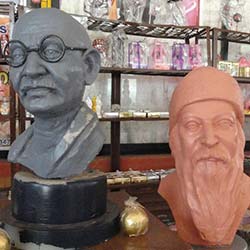
A great place of interest that promises fun is known by the name of Hollywood Wax Museum. It is a famous travel attraction in the city of Mahabaleshwar and is visited by the tourists and locals alike. This museum houses the well-sculpted wax statues of the notable personalities from the Hollywood, Bollywood, and the Indian sports industry & Politics. It Is Known For:-1) Established recently, the Hollywood Wax Museum is a must-see tourist attraction in the city.2) It is a building that houses the skillfully carved wax statues of the noted personalities from the Hollywood like Michael Jackson, Brad Pitt, Jackie Chan, The Duke & Duchess of Cambridge, Queen Elizabeth, Prince Charles, Angelina Jolie etc.3) From the sports industry, the wax statues of Baichung Bhutia, Ronaldino, Lionel Messi, David Beckham, Sachin Tendulkar etc.4) From the Indian Politics, there are the wax statues of Anna Hazare, PM Narendra Modi, Atal Bihari Vajpayee.5) The idol of the renowned musician A.R Rahman holding the Oscar is also installed in the museum. Soon, more wax statues of other personalities will be added.Best Time To Visit:-There is no special time or season for paying a casual visit to the Hollywood Wax Museum. This place catches the attention of visitors throughout the year. Thus, one can mark his/her presence during any time of the year.The entry to this museum is paid for all visitors without any special discount.Reaching There:-Due to the location of the museum in a bustling region, it has a well-established connection of roadways and railways. Numerous local buses, taxis, and autos ply on its route in plenty.Nearest Railway Station:- Pune JunctionNearest Airport:- Pune International Airport
Explore More